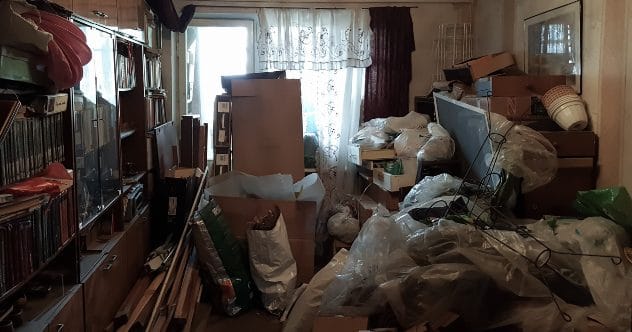Hoarding disorder is a complex issue that extends far beyond just having a messy house. While many are familiar with the visible clutter, the true impact of hoarding often remains hidden. It’s a condition that deeply affects not only the individual struggling with it but also their family and loved ones. Often, those with hoarding tendencies are unaware or find it difficult to admit they have a problem, allowing possessions to gradually take over their lives. Cleanliness and organization are just the surface; many other concerning side effects can arise from hoarding. Let’s explore ten lesser-known consequences of hoarding that often go undiscussed.
10. Hoarding Often Leads to Financial Difficulties
In severe hoarding situations, individuals can become virtual prisoners in their own homes as piles of items grow, shrinking usable living space. This extreme disorganization makes finding anything, especially important documents, a monumental task. Imagine searching for your keys in a hoarder’s home – now apply that to credit cards, bills, social security information, receipts, vital mail, tax documents, or even paychecks. Mail might go unopened, resulting in late fees, mounting debt, and other serious financial setbacks.
Financial strain also comes from the compulsive acquisition of items. While many hoarders might see themselves as being frugal, their overflowing homes often tell a different story. Thus, financial difficulties frequently plague hoarders due to an inability to locate essential items and manage their finances effectively amidst the chaos.
9. Obesity Is a Side Effect of Hoarding
There’s a notable tendency for individuals who hoard to also struggle with obesity, for a couple of key reasons. Firstly, the sheer volume of possessions in a hoarder’s home drastically reduces maneuverable space. Less room to move means individuals are more inclined to be sedentary, spending more time sitting. As the hoard grows, living space shrinks, making physical activity difficult and weight gain, leading to obesity, more probable.
Secondly, psychological factors play a role. Hoarding is often linked with Obsessive Compulsive Disorder (OCD), where individuals feel a psychological urge to keep items others would discard. OCD itself is also associated with obesity. Both conditions involve challenges with impulse control, creating a connection between the compulsion to hoard and the path to obesity.
8. Hoarding May Be a Sign of Trauma
Hoarding behaviors don’t just appear out of thin air; they are often rooted in past experiences, particularly those from childhood. Two main underlying factors contribute to hoarding tendencies:
- Trauma: Individuals who have experienced abuse, neglect, or other forms of instability during childhood, or even later in life, are significantly more prone to developing hoarding habits. The act of accumulating possessions can be a coping mechanism.
- Learned Behavior: Growing up in a household with a parent who hoards can lead children to adopt similar behaviors. Habits are often learned from parents, and hoarding is no exception.
An often overlooked side effect of hoarding is the underlying psychological distress it signals. If someone is hoarding, it’s highly likely they are dealing with other mental health issues that contribute to this behavior.
7. Potential Links Between Hoarding and ADHD
As noted, hoarding is frequently connected to various mental health conditions, including Attention Deficit Hyperactivity Disorder (ADHD). ADHD is a fairly common disorder characterized by symptoms such as inattention, hyperactivity, and impulsivity. These symptoms can amplify the urge to hoard and intensify the resulting negative consequences.
Individuals with ADHD often struggle with prioritization and organization, which can easily worsen hoarding habits. This connection between hoarding and ADHD is a rarely discussed but significant aspect. In some instances, appropriate medication and therapy for ADHD can help individuals gain better control over their hoarding tendencies.
6. Hoarding Can Lead to Stress or Even Depression
For many, letting go of things can be a freeing experience, whether it’s an old grudge or clothes that no longer fit. Hoarders, however, take the opposite approach, clinging to possessions in the belief that these items will bring them happiness. The reality is that managing, storing, and the general state of these accumulated items can significantly increase stress levels. It’s challenging to relax in a cluttered, untidy environment, leading to higher chronic stress for hoarders.
Hoarding can also foster isolation. Individuals may feel embarrassed to invite people over, and in severe cases, they might become reluctant to leave their homes. This isolation, combined with heightened stress, can pave the way for depression. Though not always immediately obvious, chronic stress and depression are clear side effects of hoarding.
5. Hoarding Can Create Legal Difficulties
Hoarders often face immense challenges with home organization, even if they don’t always recognize it. This disarray extends to managing crucial paperwork. Keeping track of taxes, insurance policies, wills, and other important documents is hard enough for most people; in a hoarder’s home, it becomes nearly impossible.
Sometimes, due to underlying psychological issues, hoarders may not seek help to find these lost documents. In extreme cases, vital legal notices, like a court summons or jury duty notification, can be lost in the clutter, leading to missed legal obligations. Furthermore, hoarders can face legal action from landlords, neighbors, or homeowners associations due to the unkempt state, odors, or safety hazards posed by their hoard. Legal troubles are a very real, though often unconsidered, side effect of hoarding.
4. Hoarding Can Be Personally Unclean and Even Dangerous
From an outsider’s perspective, hoarding might seem like a minor issue, sometimes even dismissed lightly. However, hoarding is a serious and dangerous habit. Homes affected by hoarding are often unsafe environments due to a lack of cleaning, presence of rotting food, unsanitary bathroom conditions, mold growth, and poor air quality—all serious hygiene concerns. In worst-case scenarios, hoarders may block off entire sections of their homes, storing items in bathtubs, showers, or even on top of essential appliances like toilets and refrigerators.
This may seem almost comical to an outsider, but the grim reality is that piles of possessions can obstruct entrances and exits, eliminating escape routes in emergencies. The abundance of flammable materials like paper drastically increases fire risk, and the clutter heightens the chance of trips and injuries. Hoarding creates an environment that is personally dangerous and unsanitary.
3. Hoarding Often Causes the Mistreatment of Pets
As highlighted, hoarding can be personally unsafe. However, it poses an even greater danger to innocent pets who share the home. Most pets live indoors, meaning they breathe the same potentially hazardous air and consume food and water within that environment. This neglect is not only unethical but can also be a crime, sometimes as serious as a felony. When hoarders mistreat animals, which can include hoarding excessive numbers of animals, they may face consequences such as:
- Fines
- Eviction from the home
- Forfeiture of the animal(s)
- Jail time
Improper care or mistreatment of animals is a tragically common, yet often overlooked, side effect of severe hoarding habits.
2. Hoarding Can Lead to Homelessness
When hoarding reaches a critical point, authorities or landlords may intervene and remove the hoarder from their home. If a property violates local health and safety regulations, the tenant can be evicted. This can also happen if the hoarder owns the home, in which case the building might be condemned. Such actions are drastic, and authorities generally try to avoid them.
However, once evicted, finding new housing can be extremely difficult for someone with a history of hoarding. Even homeless shelters may be hesitant to accept individuals known for hoarding behaviors. In the most severe scenarios, hoarding can result in a devastating side effect: homelessness.
1. Hoarding Leads to an Unsafe Environment for Children of All Ages
Ultimately, hoarding creates a detrimental environment for children and any other individuals living in the home. Children are particularly vulnerable to the dangers posed by hoarding. These risks include physical hazards from clutter, poor sanitation, and exposure to pests or mold. In extreme situations, child protective services may remove children from a home deemed unsafe due to hoarding.
Beyond the immediate physical dangers, children raised in hoarding environments are more likely to develop hoarding tendencies themselves later in life. Children learn habits from their parents, and while this can be positive, hoarding is a pattern no parent would wish to pass on. The impact on children is a profound side effect of hoarding that many may not immediately consider.
Conclusion
Hoarding is far more than an issue of mere clutter; it’s a multifaceted disorder with profound and often hidden consequences. From severe financial distress and serious health implications like obesity and depression, to legal troubles and the creation of physically dangerous living environments for occupants and pets, the effects are extensive. Recognizing these less-discussed side effects is crucial for understanding the full scope of hoarding disorder and the importance of seeking help and support for those affected.
What are your thoughts on these side effects of hoarding, or do you know of others that weren’t mentioned? Leave your comment below!










